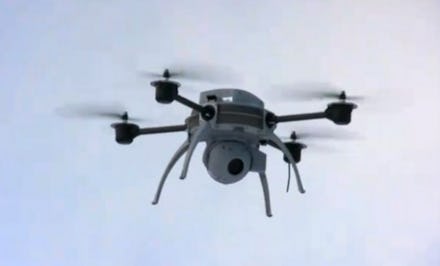This is the Next Big Thing in Retail — Worth Billions Of Dollars

The News: Amazon CEO Jeff Bezos isn't the only one with plans to raise a private army of drones. According to a recent article in USA Today, the underground drone economy is booming, with business owners from all across the spectrum rushing to buy in to the unmanned market.
"Real estate specialist Manie Kohn uses drones to video luxury properties. Terence Reis flies them to photograph surfers. Brad Mathson monitors farmland in the Dakotas, while Ryan Kunde uses a drone to improve production at his vineyard."
Oil and gas companies use drones to chart resource maps and monitor production, while there are obviously unlimited applications for camera-carrying drones in sports and the movie industry.
Most commercial drones are still outside of the United States, because the Federal Aviation Administration (FAA) hasn't published draft versions of any regulatory controls yet. But they're quickly working on it, and when they do, the drone economy is likely to explode. According to the Association For Unmanned Vehicle Systems International, the first three years of drone implementation will raise $13.6 billion and could top $82 billion from 2015-2025, creating 70,000 new jobs and 34,000 manufacturing positions in those first three years. (Its 10-year prediction is 100,000 jobs.)
While those numbers are pretty optimistic, that's still big money, and it's all just sitting there waiting to take off.
Why should I care? Drones aren't just for launching Hellfire missiles at Pakistani weddings. In case you missed Bezos' announcement, 30-minute drone delivery is of Amazon's goal within the next four-five years, meaning that they could also be for launching horse head masks long past their ironic prime directly onto your face. And there are pretty much unlimited applications for unmanned aerial drones in other industries.
Here's what drone cinematography looks like, for example:
As VICE's Brian Anderson observes, "... This sort of first-person view, of which more and more hobbyists and cinematographers are seeking from small, moderately-priced quad- and hexacopters and imagers, is inherently arresting. It almost can't not be arresting."
Manie Kohn, a real estate agent interviewed by USA Today, spent $45,000 developing drones, training for flight, and acquiring certifications and insurance all so that he could take stunning aerial photographs of properties that used to require $20,000 in helicopter services.
And Dakota Precision Ag Center is using $3,000 drones to collect massive amounts of agricultural data. Traditional methods can survey 100-300 acres of farmland. The drones can cover 2,000-3,000. That's a lot of efficiency.
Furthermore, drones can be used in search-and-rescue operations, potentially saving lives.
What's the catch? Well, actually, there's just as many drawbacks.
For one, there's the unmistakable Orwellian overtones of a thousand robots constantly buzzing overhead. Regulations are fine and dandy, and it's unclear how strict they'll be. But it seems inevitable that eventually the status quo will change and there will be lots and lots of drones. Is the government (or really, anyone) capable of tracking each of these? Will the skys be covered in unidentified flying objects, carrying unknown payloads? Anyone could be filming you without your consent, not just the government. Even darker:
Conventional air traffic can already be pretty unsafe. It's not alarmist to ponder the risks of more aircraft, especially low-flying unmanned vehicles in urban areas.
Drone usage has also been limited or completely restricted in some states, as this no-drone zone map shows:
On the other hand, drones could help level the playing field in other ways. Demonstrators in Poland, for example, have already deployed their own aerial vehicles to catalogue police actions during mass protests.